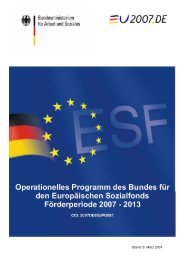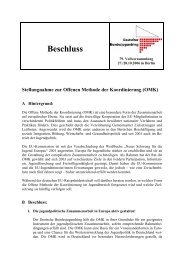6 Country Reports on Youth Work - Jugendpolitik in Europa
6 Country Reports on Youth Work - Jugendpolitik in Europa
6 Country Reports on Youth Work - Jugendpolitik in Europa
Create successful ePaper yourself
Turn your PDF publications into a flip-book with our unique Google optimized e-Paper software.
68<br />
� <strong>in</strong> some countries data <strong>on</strong> participants is generated from youth polls and surveys at<br />
nati<strong>on</strong>al level (Austria, Ireland, Norway);<br />
� there is no data available at nati<strong>on</strong>al level <strong>in</strong> Italy, Greece or the Netherlands.<br />
Tak<strong>in</strong>g <strong>in</strong> c<strong>on</strong>siderati<strong>on</strong> the diversity of nati<strong>on</strong>al data about youth work and the difficulties that<br />
have to be faced when report<strong>in</strong>g at European level has to be comparative, the <strong>in</strong>dicators<br />
shown below are recommended as the start<strong>in</strong>g po<strong>in</strong>t for a future report<strong>in</strong>g structure. They are<br />
based <strong>on</strong> statistics available from EUROSTAT as well as <strong>on</strong> data from the Eurobarometer<br />
2007 Survey <strong>on</strong> <strong>Youth</strong>.<br />
Only a limited amount of quantitative data from the present study can be added to this data.<br />
At nati<strong>on</strong>al level, the available data refers to the nati<strong>on</strong>al public spend<strong>in</strong>g c<strong>on</strong>tributed by<br />
m<strong>in</strong>istries target<strong>in</strong>g youth issues. This data can be related to total public spend<strong>in</strong>g, but it must<br />
be kept <strong>in</strong> m<strong>in</strong>d that funds allocated by other m<strong>in</strong>istries are not traceable. In additi<strong>on</strong>, <strong>in</strong> most<br />
countries state and municipal authorities c<strong>on</strong>tribute to a high degree to the f<strong>in</strong>anc<strong>in</strong>g of youth<br />
work. To some extent it is also possible to map the percentage of associati<strong>on</strong>s perform<strong>in</strong>g<br />
youth work and the ratio of paid youth workers to volunteers.<br />
Furthermore, we have found <strong>in</strong>terest<strong>in</strong>g categories such as<br />
� the number of youth associati<strong>on</strong>s organised at nati<strong>on</strong>al level;<br />
� the ratio of full-time employed youth workers and young people;<br />
� the proporti<strong>on</strong> of participants <strong>in</strong> youth work per 10,000 or 100,000 children and young<br />
people;<br />
� the average number of youth workers per <strong>in</strong>stituti<strong>on</strong>;<br />
� and f<strong>in</strong>ally the amount spent for each participat<strong>in</strong>g child or young pers<strong>on</strong>.<br />
These categories are nevertheless no more than <strong>in</strong>dividual examples that cannot be<br />
recommended, as the basic <strong>in</strong>formati<strong>on</strong> necessary to calculate them is not available <strong>in</strong> most<br />
of the surveyed countries. They may, however, be helpful for a future report<strong>in</strong>g system.<br />
As this table shows, aggregatable data <strong>in</strong> <strong>in</strong>dividual areas is also <strong>in</strong>complete. The table<br />
should therefore be seen as noth<strong>in</strong>g more than an <strong>in</strong>itial and <strong>in</strong>complete attempt at<br />
classificati<strong>on</strong>.

















